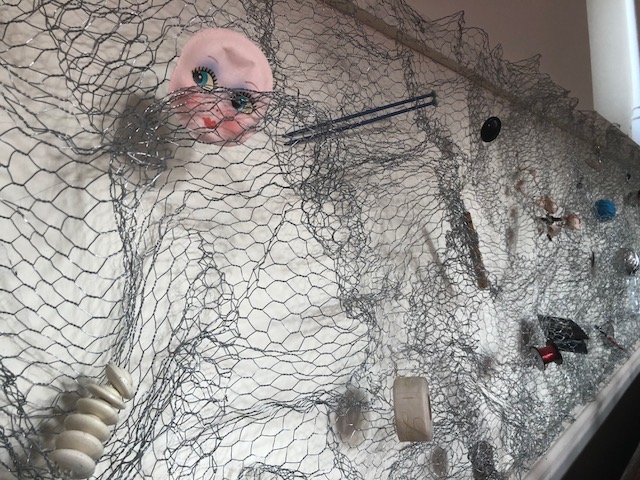Memory Installation: Art at St Peter’s
In 2017 St Peter’s was approached with a proposal from Angela Wright, following an article in The Church Times documenting experiences of artists residencies in churches in which St Peter, De Beauvoir Town was featured.
Angela had an impressive portfolio of site-specific and participatory installations in churches and cathedrals. She also had an interest in working with older people, especially those with dementia. Angela’s interest in working with memory arose when she trained with the European Reminiscence Network, as an apprentice with Pam Schweitzer on one of her Remembering Yesterday Caring Today projects (read more here).
This offered the church a valuable opportunity for outreach to older people and dementia support networks. The installation provided a backdrop to a Lent programme of Holy Conversations – stories of St Peter’s and stories of God: stories of grace and well-being, scarcity and abundance, grief and change.
Some 12 people, aged 15-95, attended the introductory workshop at St Peter’s. The objects displayed in the installation were gathered from a series of 4 memory workshops during Lent and from the artist’s own collection of things. The workshops focused on a number of themes: spring, smells, textures. Objects have a unique ability to evoke memories. As a participant in one memory workshop I was seized by completely forgotten childhood memories when another participant produced a swiss chalet musical box. My grandmother had one in the form of a musical cigarette box, a souvenir from a holiday in Interlaken at the end of the 1950s. A number of participants were willing to share stories about their memory object/s. These were collated in a folder on display. Visitors are invited to share their any of their own memories evoked by objects in the installation
50 metres of chicken wire arrived on Ash Wednesday. By the end of the week it had been formed into an ethereal gauze running the length of the walls of the nave. As an artist accustomed to working with textiles it was perhaps unsurprising that Angela was able to create such a tactile and flexible substance with the qualities of net. It was not an easy endeavour. Her hands hurt at the end of each day. The artist physically wrestling with the material had echoes of Christ physically wrestling in the wilderness. Her creative presence became a symbolic act in itself.
Angela’s original intention was to weave fabric through the wire amongst the memory objects to be displayed to create the sense of a river of memories – Lenten colours flowing into Easter colours. A number of materials were tried – ribbons, tissue paper. But each time the insertion of a different colour and texture was made, it disturbed the eloquence of the ghostly grey mesh.
As the weeks of Lent went by, more and more small objects appeared each one very carefully positioned in the mesh.
Angela says:
“Before I started to attach them I laid out all of the memorable objects on tables and they became my palette. I needed to become familiar with them. Their shapes, their colours, history and how they might live together. Finding that special resting place on the wall was not simple and it could take time, sometimes days and a small percentage of objects were rejected. The placing and space around each object was an important aspect of the installation. In the end around 430 objects were incorporated. In the final week, knitting needles were employed to help direct the sense of movement around the building. Balls of wool picking up the colours of the stained glass were used to draw the eye to the unity of the building.”
The response to the piece has been low key amongst the congregation – in a good way. The artist was anxious not to produce something that would overwhelm the worship space. The subtlety of the installation is one of its achievements. The appreciation of the piece grows by the week as people slowly take it in. At first glance you might think it was a display of leftover Christmas decorations – many of the objects are suspended and catch the changing light in the building. As you draw closer you see that each object has its own space, its own voice and viewing becomes an act of contemplation.
For the artist, it was the first time she had worked on an installation in situ:
“St Peter’s became a studio where a lot of thinking took place, a certain amount of worrying as well as the pleasure of seeing something develop. When I looked across the church to the two outer walls I could see the sunlight bouncing off the reflective objects and if I looked up at the stained glass windows I could see a relationship with the colours of the objects on the wall. I became familiar with regular visitors who came in to pray or take time out from the world outside. I met members of the congregation and the community through the workshops I ran. I was very grateful to have the time and the space to work and think things through which is very much part of a residency. It has been a very special experience.”






